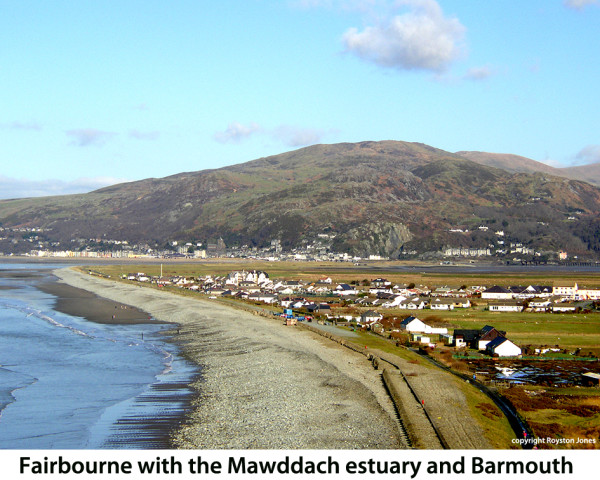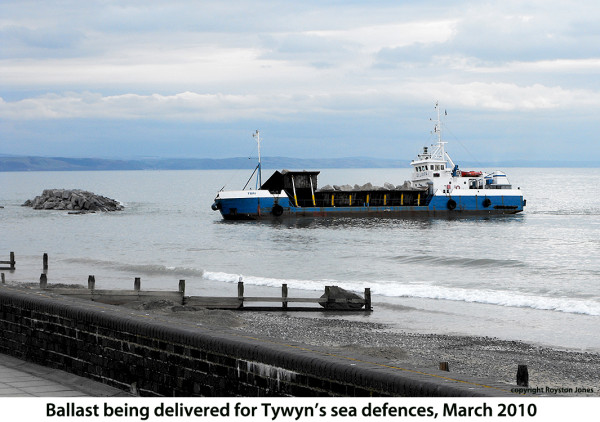Last night’s Week In Week Out on BBC 1 Wales, presented by Tim Rogers, dealt with long term problems posed by erosion or sea encroachment around our coasts, and came with the stark warning that some communities will have to be abandonded, largely because the cost involved in holding back the sea greatly outweighs the value of what is being protected. (Here is a link to the BBC iPlayer version of the programme.)
One of the communities visited was Fairbourne, which is, like most of the others consigned to ‘managed retreat’, a somewhat artificial settlement, built on land reclaimed for the purposes of tourism and retirement. The Fairbourne Wikipedia page says it all: the area was previously known as Morfa Henddol (morfa = fen or sea marsh) and the outcrop on which today stands the Fairbourne Hotel was known as Ynysfaig (ynys = island). Clearly, our ancestors knew this land alongside the Mawddach estuary for what it was. (And will soon be again.)
Also investigated was that sinkhole for Welsh public funding, Rhyl. There we saw a couple who, to judge by the accents, came from the Birmingham conurbation, had been flooded out of their bungalow and were now living in a trailer home. Tim Rogers asked if anything had been mentioned about flooding when they purchased their property. “No, nothing”, was the reply. Which made me think to myself, ‘If I am a shifty developer or estate agent, selling properties I know are vulnerable to flooding – and almost always to people who don’t know the area – am I going to tell these prospective buyers that their dream home might one day be under six feet of water?’ Of course not. This is clearly a case of caveat emptor.
Down here, on our stretch of the coast, Tywyn’s new sea defences worked excellently . . . though there are some in Tywyn that will never admit this as they harbour an irrational hatred for Gwynedd council and all its works, because it’s a) too Welsh and b) run by the wrong party. They would rather gripe and snipe at everything the council does, however beneficial.
Speaking of gripers and snipers, I hear that part of Aberdyfi golf course has joined Neptune’s realm. Sad though this news may be, there can be no justification for spending Welsh public money to preserve what is a private and exclusive asset. Either the club itself pays for new sea defences or else Nature must  be allowed to take its course (‘course’ – geddit!), leaving the Ukipistas to find another rendezvous. Further south, Borth and Aberystwyth also featured in Tim Rogers’ investigation. Now, obviously, Aberystwyth must be defended, but how strong is the case for Borth? It certainly seems that land just north of Borth – curiously enough, another golf course! – is to be surrendered.
be allowed to take its course (‘course’ – geddit!), leaving the Ukipistas to find another rendezvous. Further south, Borth and Aberystwyth also featured in Tim Rogers’ investigation. Now, obviously, Aberystwyth must be defended, but how strong is the case for Borth? It certainly seems that land just north of Borth – curiously enough, another golf course! – is to be surrendered.
Though the bigger picture here, especially when we remember the Towyn floods of 1990 and similar events, is that for a century and more we have allowed, even encouraged, the building of new properties on inadequately defended coastal plains and salt marsh, land on which building should never have been allowed. So why did this happen? The fundamental cause is tourism. Since the coming of the railways over 160 years ago English people have visited coastal Wales for their holidays, and this led to the growth of resorts where little or nothing had existed before the arrival of the iron horse. Many of those tourists wished to settle permanently, perhaps retire to, where they had enjoyed their holidays, so new homes were built for them . . . with the inevitable consequences.
If I owned a home in an area being ‘surrendered’ to the sea, I think I would be asking a few questions. Principally, ‘Why was planning permission granted for my property and others when the risk of flooding must have been known?’ Then, perhaps, ‘Do I have a justifiable claim for negligence or culpability against the body that granted planning permission’? (With this of course extending, particularly in the case of local authorities, to successor bodies.) For no matter what we may think of communities like Rhyl, Towyn and Fairbourne, the people suffering from flooding in such places a re innocent victims and have, to all intents and purposes, been conned into buying the properties under threat.
re innocent victims and have, to all intents and purposes, been conned into buying the properties under threat.
So, in the hope of avoiding any repetition of such miseries, can the puppet show down Cardiff docks, and our local authorities, confirm that no more building will take place in areas that might in future be susceptible to coastal flooding or erosion? (This must also apply to trailer parks and other developments.) More, will these bodies also confirm that any outstanding planning approvals for dwellings in such areas will be revoked? And will the ‘Welsh’ Government also promise us that there will henceforth be a binding national presumption against building any more communities like Towyn and Fairbourne?
Oh, yes, something else that would be very welcome would be a promise from the Planning Inspectorate that in future it will not – in order to follow its over-arching policy of attracting English settlers to Wales – overrule planning bodies that turn down applications for housing in flood-prone areas.
 UPDATE 12.03.14: I am indebted to the person who sent me a copy of this 1868 watercolour claiming to be a view across the Mawddach from Barmouth, showing where Fairbourne would eventually be built. You will note that there is nothing there apart from what looks like a temporary structure, perhaps a fisherman’s hut. Suggesting that the locals had better sense than to try to build anything permanent there. (Click to enlarge.)
UPDATE 12.03.14: I am indebted to the person who sent me a copy of this 1868 watercolour claiming to be a view across the Mawddach from Barmouth, showing where Fairbourne would eventually be built. You will note that there is nothing there apart from what looks like a temporary structure, perhaps a fisherman’s hut. Suggesting that the locals had better sense than to try to build anything permanent there. (Click to enlarge.)
